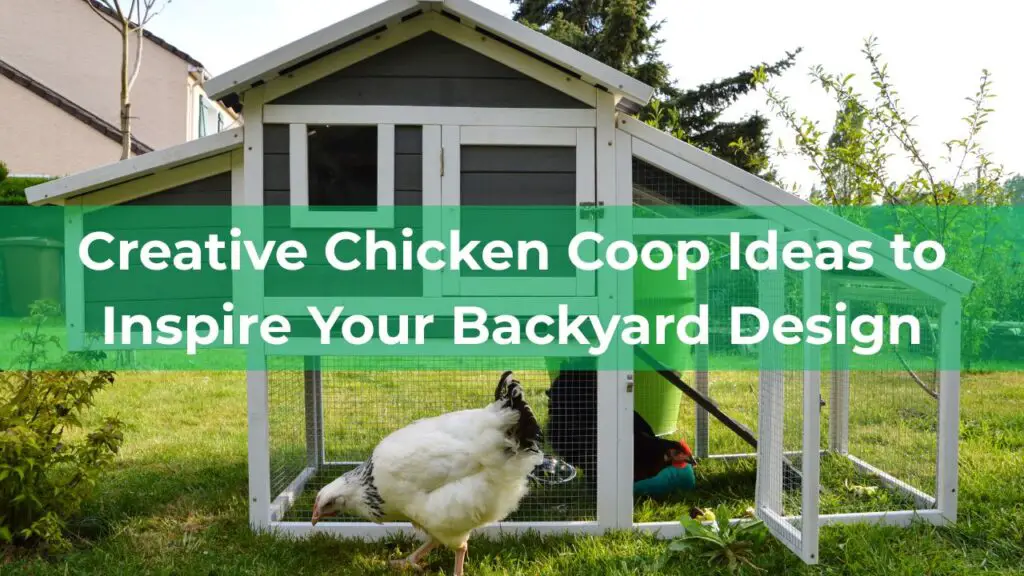Disclosure!
At The Daily Farming, your trust means everything. We use AI to help create some of our content, but every post is carefully reviewed and edited by real humans before it’s published.
Some of our images are AI-generated to help illustrate ideas, but everything you see is checked and approved by us.
Thanks for being here—we’re grateful for you!
Imagine walking into your backyard and seeing it come alive—lush garden beds bursting with veggies, herbs swaying in the breeze, and a few happy hens clucking nearby. Sounds like a dream, right? The truth is, with the right design, you can turn that dream into your everyday reality.
But here’s the thing: combining a chicken coop with a garden takes more than just placing a few raised beds next to a run. Chickens are great companions for your garden—they fertilize the soil, eat pests, and help with composting. But if the layout’s off? They’ll dig up seedlings, eat your produce, and leave you with a mess.
That’s why this guide is packed with everything you need to know about creating the best chicken coop and garden layout, including 18 practical ideas you can mix and match for your space. Whether you’re working with a tiny backyard or planning a full-blown homestead setup, there’s something here for you.
And if you’re still in the planning phase and looking for coop inspiration, don’t miss our list of 17 Creative Small Chicken Coop Ideas for Your Backyard—perfect for tight spaces—and our guide on 16 Affordable DIY Chicken Coop Designs for Your Backyard to help you save money while building something beautiful.
By the end of this post, you’ll have a solid plan to create a backyard that works in harmony—your chickens stay safe and productive, and your garden gets better every season.
Let’s jump in.
Things to Consider Before You Start Designing
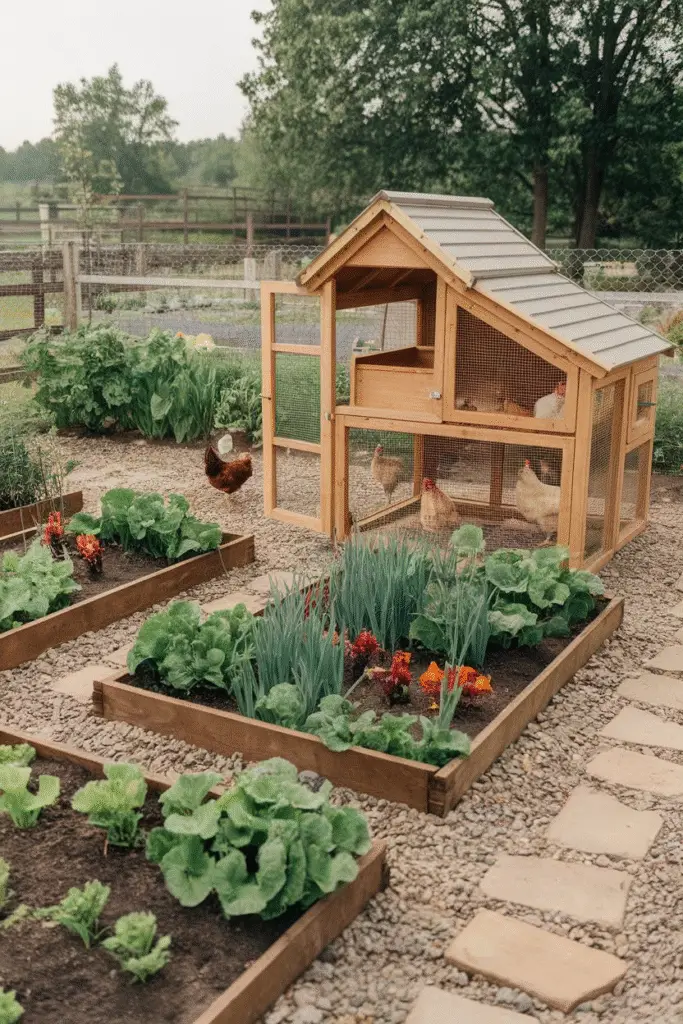
Before you dive into building the best chicken coop and garden layout, take a step back. A little planning now can save you a lot of headaches later. From space and goals to local rules, here’s what to think about before you break ground.
How Much Space Do You Really Need?
Let’s start with the basics: how much room do your chickens and your garden actually need?
For chickens, a general rule of thumb is:
- 2–4 square feet per chicken inside the coop
- 8–10 square feet per chicken in the run
But if you’re planning to let them free-range (at least part-time), you can get away with slightly less run space. Just remember: the more room they have, the happier (and healthier) they’ll be.
If you’re short on space or working with a small backyard, don’t worry—you can still create something amazing. Check out our 13 Creative Chicken Coop Ideas to Inspire Your Backyard Design for clever ways to maximize space without sacrificing comfort or style.
For your garden, think about what you want to grow and how much of it. A few raised beds may be enough for a couple of salad-loving adults. If you want to grow a serious amount of food—or add fruit trees, herbs, and flowers—you’ll need more space.
Urban vs. rural layouts also matter:
- In urban settings, you’ll need to be mindful of space, noise, neighbors, and stricter local regulations.
- In rural areas, you may have more flexibility, but it’s still smart to be intentional with your layout to keep things tidy and efficient.
What Are Your Goals?
This part might sound simple, but it really shapes your whole setup.
- Do you just want fresh eggs for your family?
- Are you dreaming of a full kitchen garden to feed your household?
- Planning to sell eggs, veggies, or both?
If you’re going all in on egg production, you’ll need space for more hens and a sturdy, secure run. In that case, a cost-effective run design is a must—take a look at How to Make a Budget-Friendly DIY Chicken Run for step-by-step ideas that won’t drain your wallet.
On the other hand, if your main focus is gardening with a few chickens as helpers (and occasional egg providers), your coop can be smaller and simpler.
Local Laws and Zoning Rules
Before you get too far in, check your local regulations. Trust me, the last thing you want is to build your dream setup only to get hit with a fine—or worse, have to take it down.
Here are a few key things to check:
- Are backyard chickens allowed in your area?
- How many chickens can you keep? (Some places ban roosters entirely.)
- Do you need a permit for your coop or garden structures?
- How far from property lines, homes, or wells does the coop need to be?
These rules can vary wildly from one town to the next, so check with your city or county before you start buying materials.
Basic Chicken Coop Design Principles
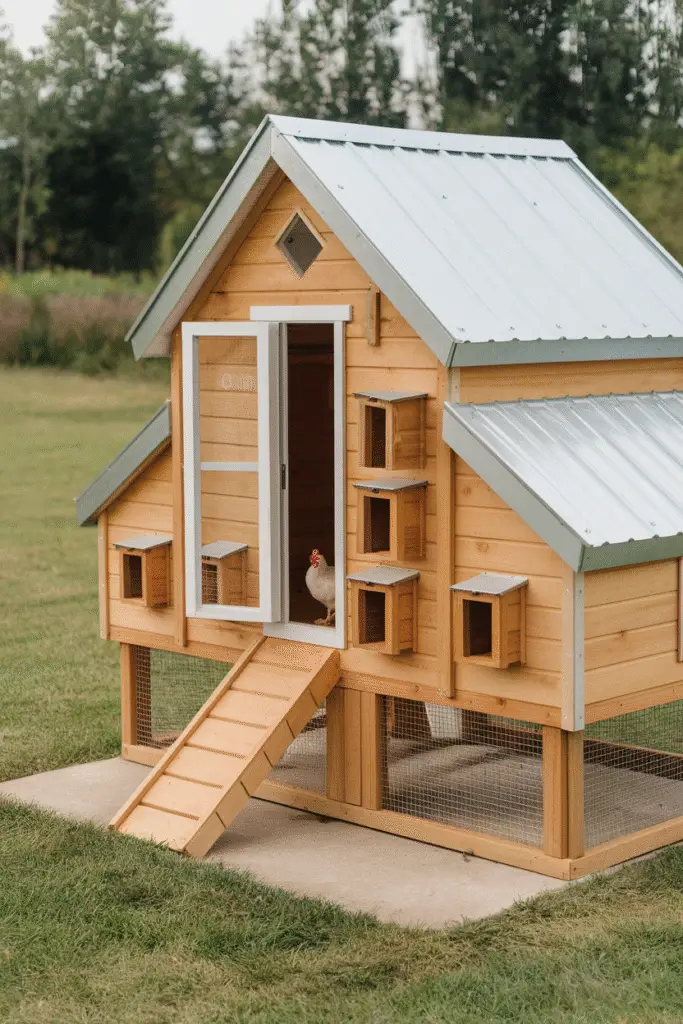
A good chicken coop isn’t just a box with a roof. It’s your flock’s home, their safe space, and a big part of what keeps them healthy and productive. Whether you’re building from scratch or tweaking an existing setup, here are the key design principles to keep in mind.
Coop Size and Dimensions
Let’s talk numbers.
As a rule of thumb:
- 3–4 square feet per chicken inside the coop
- 8–10 square feet per chicken in the run
Don’t forget—bigger is usually better. Chickens hate being cramped. A cramped coop leads to stress, fighting, and lower egg production.
Make sure there’s enough headroom, too. You should be able to walk in easily (or at least crouch) if you want to make cleaning and collecting eggs less of a chore. This is especially important in setups that combine the coop and run into one walk-in unit, like in some of the designs from our post on 14 Creative Chicken House Ideas for Your Backyard Farm.
Ventilation, Light, and Insulation
These three elements are often overlooked—but they’re essential.
Ventilation helps prevent moisture buildup, ammonia buildup from droppings, and respiratory issues. Aim for vents along the top of the coop (under the eaves) so air can circulate without creating drafts.
Natural light is also a game changer. Chickens need sunlight to lay eggs consistently. Position your coop to catch the morning light if possible. You can even install clear roof panels or windows to maximize daylight.
As for temperature control, think insulation:
- In winter, it keeps your hens warm.
- In summer, it helps keep the coop cool (especially if you add shade or plant vines nearby).
Bonus tip: Proper insulation also keeps noise and smells down—which your neighbors will thank you for.
Predator-Proofing Tips
Even in the suburbs, predators are a real threat. Raccoons, hawks, snakes, coyotes—they all love an easy chicken dinner.
Here’s how to protect your flock:
- Use hardware cloth, not chicken wire (raccoons can tear through chicken wire like it’s string).
- Bury fencing 12–18 inches underground to stop digging predators like foxes and dogs.
- Add a secure lock on the door (raccoons are surprisingly good at opening latches).
Nesting Boxes and Roosting Bars
Comfortable hens are productive hens. And that starts with the right setup inside the coop.
Nesting boxes: You’ll need 1 box for every 3–4 hens. Line them with straw or wood shavings, and place them in a quiet, shaded part of the coop to encourage laying.
Roosting bars: Chickens instinctively roost at night to feel safe. Place bars higher than your nesting boxes to avoid hens sleeping (and pooping) where they lay eggs. For cozy and creative perch ideas, take a look at our article on Chicken Roost Ideas – Creative, Safe, and Comfortable Roosting Options for Your Flock.
Spacing tip: Allow about 8–12 inches of roost space per bird to avoid crowding.
Cleaning and Maintenance
No one likes a dirty coop—especially your chickens.
Design your setup to make cleaning as easy as possible:
- Use sloped floors or removable trays under roosts to catch droppings.
- Choose drainage-friendly flooring like linoleum or sealed wood for quick cleanups.
- Add a compost bin nearby to turn droppings into rich garden fertilizer.
A clean coop means healthier birds, fewer pests, and way less smell.
And don’t forget accessibility: wide doors, hinged roofs, or removable panels make everything from cleaning to egg collection way simpler.
Smart Garden Design Principles to Complement Your Chicken Coop

Your garden and chicken coop don’t have to be separate worlds. In fact, when planned right, they can work together beautifully. You can grow healthy food, give your chickens a clean, productive environment—and even turn waste into something useful.
Here’s how to design a smart garden that complements your chicken setup perfectly.
Raised Beds vs. In-Ground Planting
When it comes to growing your veggies, you’ve got two main choices: raised beds or in-ground planting. Each has its perks—and a few things to watch out for.
Raised beds:
- Easier to control soil quality and drainage
- Less bending (great for your back!)
- Warm up quicker in spring
- Look neat and tidy
But… chickens love jumping into them. Dust baths and scratching can turn your kale into chaos fast. If you go this route, make sure to add barriers—like chicken wire arches or mesh tunnels—to keep your flock from snacking on your seedlings.
In-ground beds:
- More affordable (no materials needed)
- Easier for large garden spaces
- More natural for companion planting and spreading crops
On the downside, they’re harder to protect from chickens, pests, and flooding.
No matter which option you pick, consider the placement. Position your garden away from the coop doors to prevent accidental chicken escapes into your lettuce patch!
Companion Planting With Chickens in Mind
You’ve probably heard of companion planting for pest control and productivity—but have you tried it with chickens in mind?
Here’s a trick: plant things your chickens don’t like around garden beds as natural borders.
Plants chickens tend to avoid:
- Lavender
- Rosemary
- Mint
- Marigolds
- Lemon balm
Not only do these help deter curious peckers, but they also attract pollinators and smell amazing.
Plants that are safe and even beneficial for chickens:
- Sunflowers (seeds = healthy treat)
- Swiss chard
- Kale
- Cucumbers
- Squash
Chickens love to nibble—and forage—so planting safe edibles near their run can give them a snack without harming your main crops.
Paths, Fences, and Barriers
If you want harmony between garden and coop, barriers are your best friend.
Chickens are curious little escape artists. Without fencing, you’ll constantly be shooing them away from your tomatoes.
Why fencing matters:
- Protects your plants
- Keeps your chickens safe from predators
- Helps create distinct zones (coop, run, compost, garden)
Best fencing options:
- Low garden fencing (2–3 feet) around beds
- Chicken tunnels or “chunnels” (enclosed paths for chickens to roam safely)
- Decorative fencing with wire mesh for beauty and function
It’s all about balance—your chickens can still roam nearby, forage for bugs, and help fertilize the soil, without destroying your garden in the process.
Composting with Chicken Waste
One of the coolest parts of owning chickens? They turn food scraps and garden waste into premium fertilizer.
Here’s how to do it right:
What to compost:
- Chicken manure
- Straw or wood shavings from the coop
- Veggie scraps
- Garden clippings
What to avoid:
- Too much fresh manure (it’s high in nitrogen and can burn plants)
- Meat, dairy, or oils (attract pests)
How to compost safely:
- Use a dedicated compost bin or pile
- Let it sit for at least 6 months to break down pathogens
- Mix “greens” (like manure) with “browns” (like straw) for a balanced compost
- Turn the pile regularly
The result? Rich, nutrient-packed compost that’s gold for your garden beds.
18 Genius Ideas for the Best Chicken Coop and Garden Layout
Designing the perfect chicken coop and garden combo isn’t just about saving space—it’s about creating a system where your chickens and plants actually help each other thrive. Whether you’ve got a small backyard or a sprawling homestead, these smart ideas can inspire a functional, beautiful, and productive garden layout with a chicken coop at its heart.
Here are 18 creative and practical layout ideas to try:
1. Chicken Tunnel Between Garden Rows

Description:
Also called a “chunnel” (chicken + tunnel), this setup gives your flock access to bugs and weeds between garden rows without letting them into your main planting beds.
Benefits:
- Natural pest control
- Safe, enclosed roaming
- Keeps chickens out of your veggies
Watch Out For:
Make sure the tunnel is secure from predators and tall enough for easy movement.
2. Central Coop with Radiating Garden Beds

Description:
Place the chicken coop in the center of your garden with paths or beds radiating outward like spokes on a wheel.
Benefits:
- Easy access to compost and eggs
- Efficient layout for watering and feeding
- Visually stunning design
Watch Out For:
Ensure there’s good drainage under and around the coop to avoid runoff into your garden beds.
3. Chicken Tractor in Rotating Garden Zones
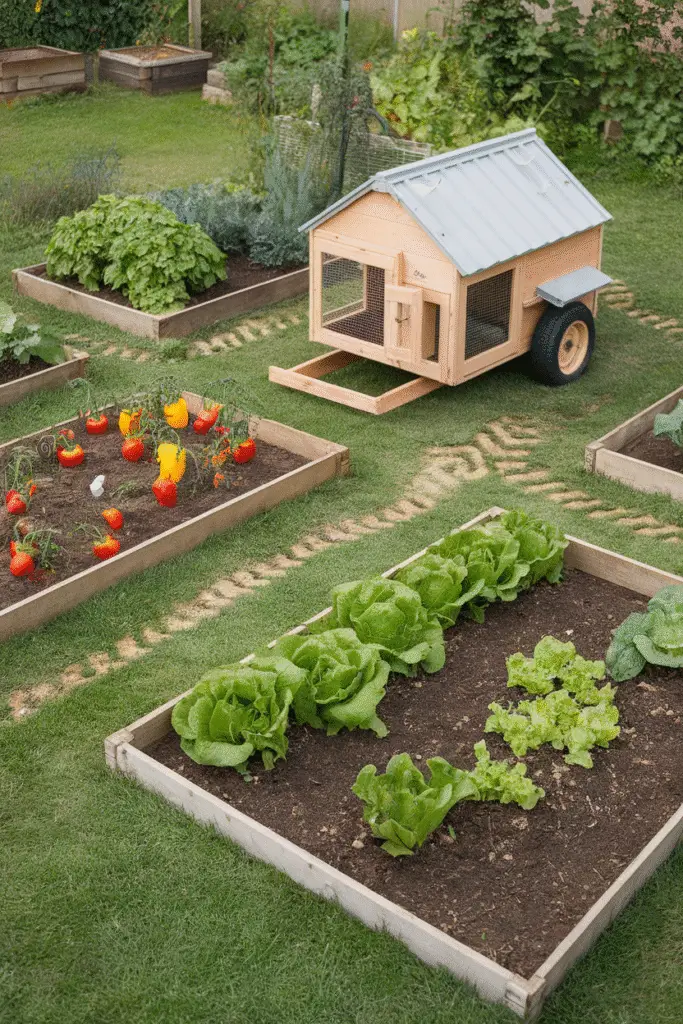
Description:
Use a mobile chicken coop (aka chicken tractor) to move your flock across different garden zones on a rotating basis.
Benefits:
- Natural fertilization
- Weed and bug control
- Healthier soil over time
Watch Out For:
Chickens may over-scratch an area if left too long. Rotate every few days for best results.
4. Shared Fence Between Garden and Chicken Run

Description:
Place your chicken run and garden side by side, using a single fence as a shared barrier.
Benefits:
- Saves space and fencing costs
- Chickens can peck bugs off garden edges
- Encourages more interaction with your garden
Watch Out For:
Some curious hens may try to sneak through. Use fine mesh or add a border of plants they dislike, like rosemary or mint.
5. Vertical Garden Walls Around the Coop

Description:
Attach planters or trellises to the coop exterior to grow herbs, strawberries, or flowers vertically.
Benefits:
- Space-saving garden layout
- Shade for the coop in hot weather
- Easy access to herbs and edible greens
Watch Out For:
Avoid planting anything toxic to chickens—especially if they can reach the lower tiers.
6. Garden Roof on Top of the Coop

Description:
Add a living roof to your coop structure, using it as a planter for shallow-rooted greens, herbs, or pollinator plants.
Benefits:
- Beautiful and eco-friendly
- Insulates the coop naturally
- Dual-purpose use of space
Watch Out For:
Make sure your coop roof is strong enough to support soil and water weight. Also, provide good drainage.
7. Herb Spiral Next to the Coop for Natural Bug Repellent

Description:
A herb spiral is a circular, raised bed with herbs planted based on their sunlight and water needs. Place it near your coop to repel bugs naturally.
Benefits:
- Repels flies and pests
- Attracts pollinators
- Provides culinary herbs for you and forage for your flock
Watch Out For:
Stick to herbs that are safe for chickens—no garlic or onion.
8. Keyhole Garden with Coop in the Center

Description:
A keyhole garden is a raised bed shaped like a keyhole, often with compost in the middle. Place your coop in the center for ultimate efficiency.
Benefits:
- Easy composting system
- Efficient watering and nutrient cycling
- Compact, productive design
Watch Out For:
Keep the coop raised or offset slightly to prevent too much runoff into your beds.
9. Chicken Compost Corner
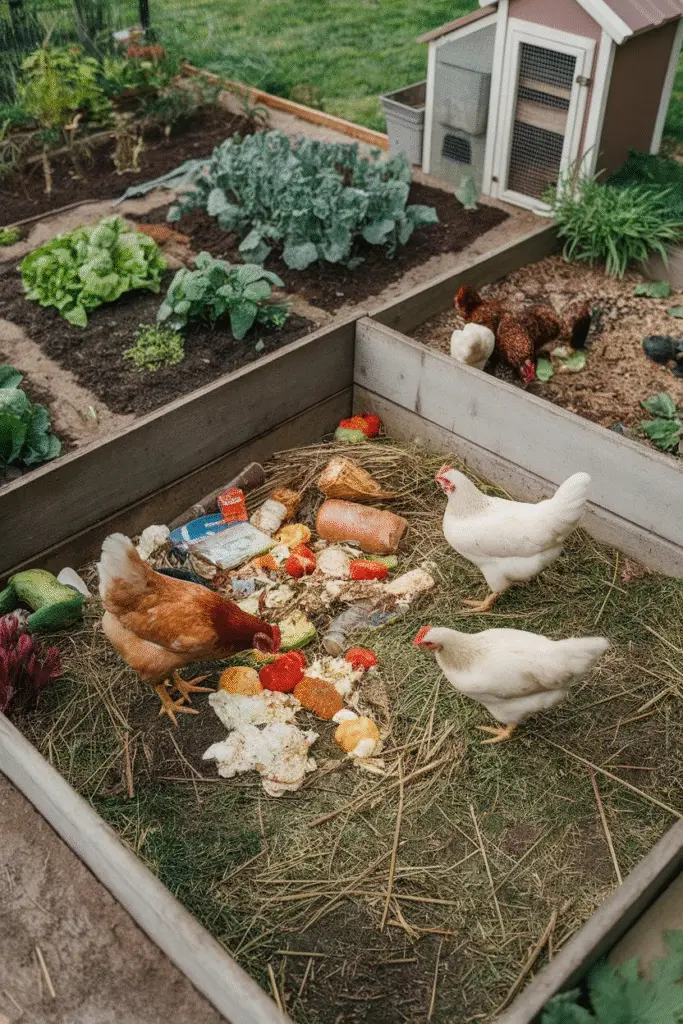
Description:
Designate a garden corner as your chicken-powered compost area. Toss kitchen scraps, bedding, and yard waste in, and let the chickens do the turning.
Benefits:
- No need to manually turn compost
- Fast breakdown of organic waste
- Keeps chickens entertained
Watch Out For:
Make sure chickens can’t access anything moldy, salty, or toxic. Fence off plants you don’t want scratched to bits.
10. Rainwater Harvesting System for Coop and Garden

Description:
Why pay for water when nature’s giving it away for free? Set up a rainwater harvesting system that collects rain from your chicken coop roof and funnels it into barrels or tanks. This free liquid gold can be used to water your plants, hydrate your chickens, or even give your coop a good ol’ cleaning.
Benefits:
- Free water? Yes, please!
- Eco-friendly (Mother Nature approves)
- Helps lower water bills (goodbye, guilt from those pricey garden hoses)
Watch Out For:
Don’t forget to filter that water! We’re talking about water that’s come through some chicken feathers, after all. Also, make sure you’re not breaking any local laws—because we all know “free” water might not be free everywhere.
11. Garden Pathway as Chicken Run (Temporary Access)
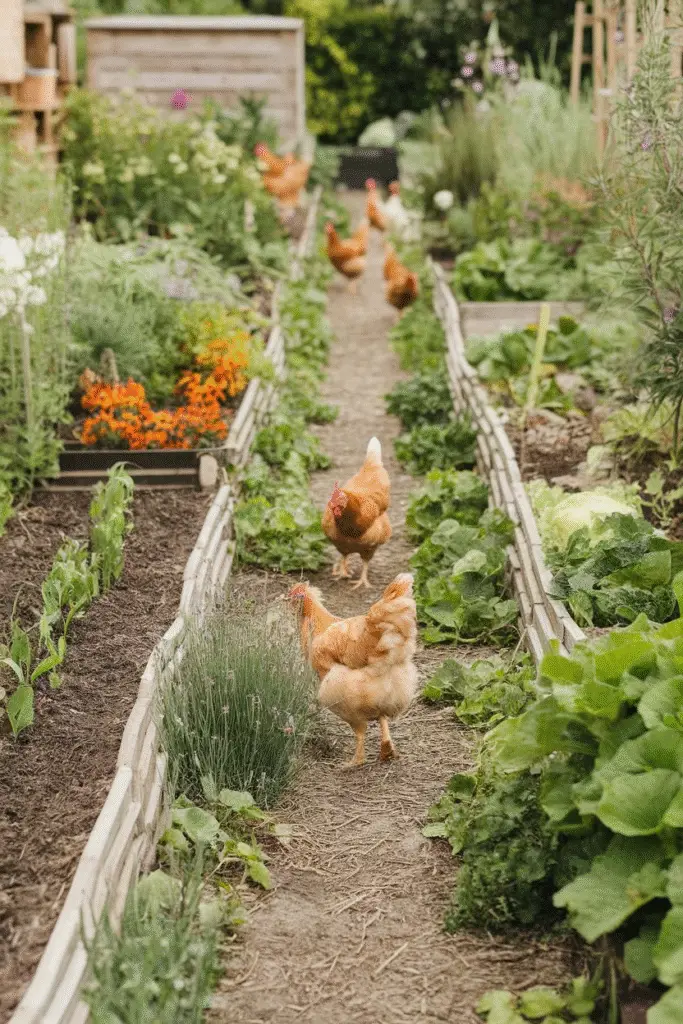
Description:
Design a garden pathway that does double duty as a chicken run. This way, your chickens can take a little stroll through your garden without being let loose on your precious veggies. Just set up a simple path with some low fencing, and boom—free-range chickens on a leash (well, sort of).
Benefits:
- More space for your chickens to strut their stuff
- Keeps chickens away from your garden without guilt
- A little extra help in the “natural fertilizer” department
Watch Out For:
Keep an eye on those little feathered escape artists. If there’s a hole, you know they’ll find it. Also, remember that chickens might mistake your seedlings for snacks—watch those plants closely!
12. Dual-Zone Layout (One for Chickens, One for Plants)
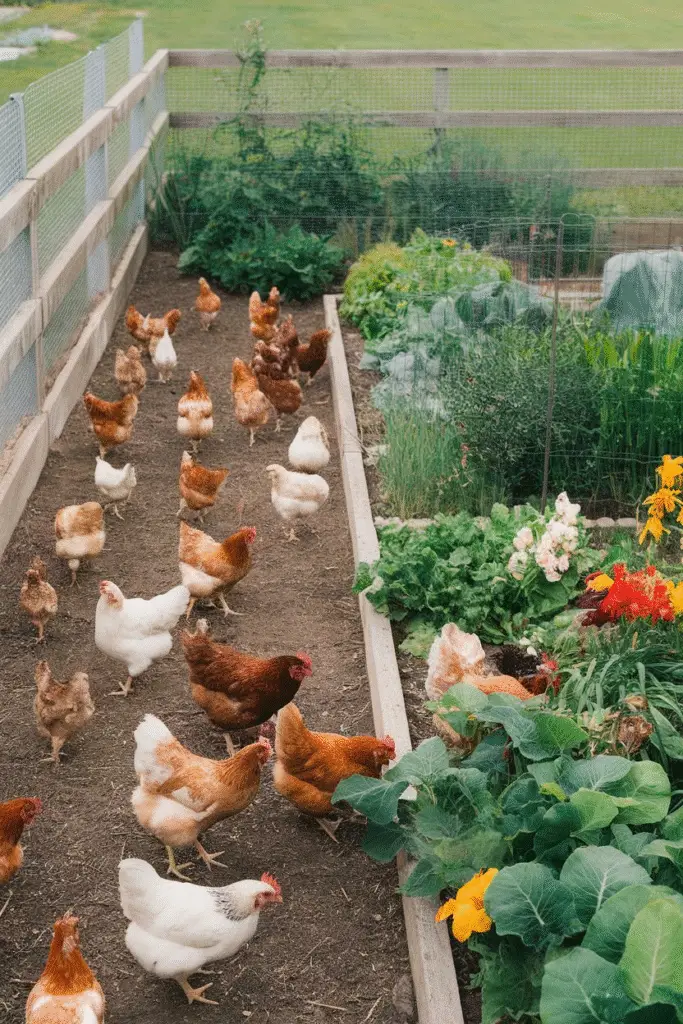
Description:
Create a layout that splits your garden into two sections: one for the chickens and one for your crops. Think of it like a chicken penthouse with a lovely garden “no chickens allowed” sign. Fences or barriers keep the two worlds from colliding.
Benefits:
- Your veggies stay safe and sound
- Chickens get their own space to peck, scratch, and live their best life
- Perfect harmony between your flock and your flora
Watch Out For:
Make sure the fence is chicken-proof. Chickens are surprisingly sneaky, and if there’s a gap big enough to fit a beak, they’re in your garden faster than you can say “fresh eggs.”
13. Modular Raised Beds with Chicken-Proof Covers
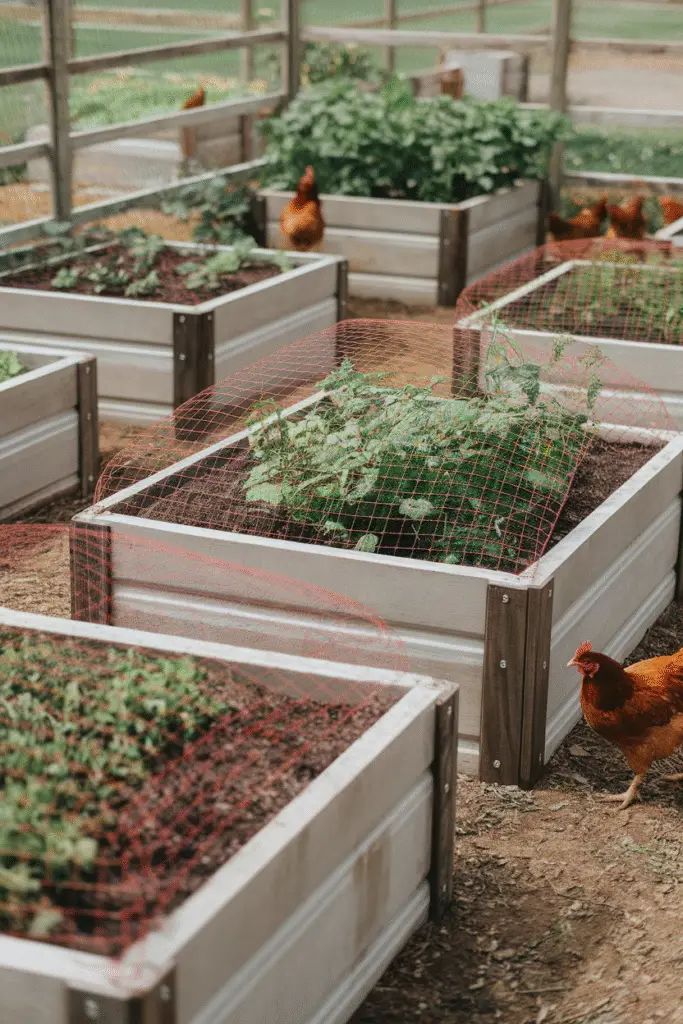
Description:
Set up raised garden beds with chicken-proof mesh or netting that can be lifted when your plants are mature. It’s like giving your plants a high-security fence, but for chickens. It’s a bit like putting them in a chicken-free spa—peaceful and untouched.
Benefits:
- Keeps your plants safe from chicken pecking
- You get the flexibility of covering and uncovering as needed
- A clean, organized garden layout (the chickens will never know the difference)
Watch Out For:
The chickens are crafty—they’ll try to wiggle their way in. Be sure to secure that chicken-proof netting tighter than a chicken’s grip on a juicy worm.
14. Portable Coop with Rotational Grazing in Garden
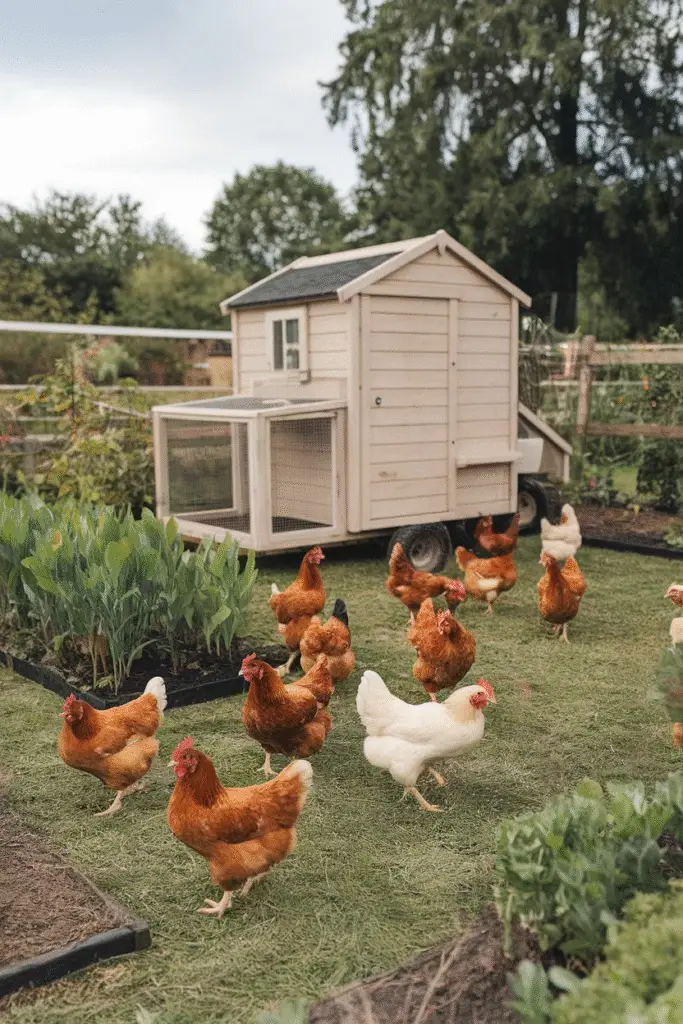
Description:
You know how your chickens love fresh grass and bugs? Give them a portable chicken coop (aka chicken tractor) that you can move around the garden. This way, they get a new patch of land to explore, while also fertilizing your garden in the process. It’s like chicken squatters—minus the mess.
Benefits:
- Fresh grass and bugs? Happy chickens.
- Rotating your coop means your garden gets that sweet natural fertilizer
- Prevents the chickens from turning one spot into their personal spa (a.k.a. overgrazing)
Watch Out For:
If you’re moving the coop around, make sure the chickens are still cozy and safe from the elements. Nobody likes a soggy chicken.
Bonus Tips for a Healthy Chicken Coop and Garden Layout
Sometimes, it’s the little things that can make all the difference when designing your chicken coop and garden. These bonus tips will help ensure that both your chickens and your plants thrive!
How to Keep Chickens Out of Garden Beds (Without Stressing Them Out)
Let’s face it, chickens can’t resist a good garden feast, and they’ll gladly dig up your plants if given the chance. But you don’t want to stress your feathered friends out by locking them out completely, right?
Solution:
Use chicken-friendly barriers like low fences or mesh covers. Try setting up small garden “corrals” where chickens can roam but still keep them away from the plants. Planting some herbs (like lavender or rosemary) around the garden beds can also help distract them—because, let’s be real, chickens aren’t the best at resisting tasty greens, but they’ll be way too distracted by the smells of herbs to bother your veggies.
Dealing with Mud, Smell, and Flies
A chicken coop without proper management can turn into a stinky, muddy mess. And while chickens are great at fertilizing the land, they’re not so great at keeping things clean. Here’s how to keep the situation under control:
Solution:
- For mud: Add gravel or straw to the coop floor to absorb moisture. If the weather’s been extra wet, you can install a drainage system underneath the coop to keep things from getting too soggy.
- For smells: Keep the coop well-ventilated and clean. Use a deep bedding system that you can easily replace every few months. Add diatomaceous earth or a natural odor-reducing agent to keep things fresh. For the garden, mulch can help absorb any lingering smells, and some plants like marigolds are known to mask odors.
- For flies: Use fly traps or natural remedies like herbs (think basil, mint, and rosemary) to deter flies. Also, don’t forget to remove any uneaten food scraps or chicken manure from the coop regularly to reduce fly attraction.
Seasonal Adjustments: Summer vs. Winter Layouts
As the seasons change, so should your chicken coop and garden layout. Here’s how to adjust your setup for year-round comfort and productivity:
- Summer Layout: In hot weather, make sure your chickens have plenty of shade and access to fresh water. Shade cloths or building a shaded area in the garden for them to hang out in will keep them cool. In the garden, it’s time to add mulch around plants to keep the soil from drying out. You can also use your chickens to help fertilize garden areas by letting them graze between garden rows.
- Winter Layout: In winter, your chickens will need a bit more shelter from the cold, so think about adding insulation to the coop or creating a windbreak around their area. To help your plants survive, make sure they’re protected from frost with row covers or cold frames. Your chickens may need less space to roam, so you can focus on keeping their area dry and warm.
Best Plants to Grow Near Your Coop (Low Maintenance, High Reward)
Not all plants are created equal, and some are just perfect for growing near your chicken coop. Here are a few that are low maintenance and thrive in your chicken-friendly garden:
- Herbs: Most chickens love fresh herbs, but they also provide natural pest control and are easy to grow. Try mint, basil, and oregano. Plus, these plants smell great and will help keep your garden smelling fresh.
- Edible Flowers: Chickens love pecking at things like nasturtiums, which are also edible for humans and help attract beneficial insects. Plus, they’ll give your garden a pop of color.
- Perennials: Plants like chives, thyme, and lavender are hardy and require little upkeep. They also help keep bugs at bay, benefiting both your chickens and your plants!
The Bottom Line
Now you’re all set to create the perfect chicken coop and garden combo! With these tips, your chickens will be content and your garden will flourish. It’s time to roll up your sleeves, get creative, and make your backyard the best it can be. Enjoy the process, and happy gardening!

